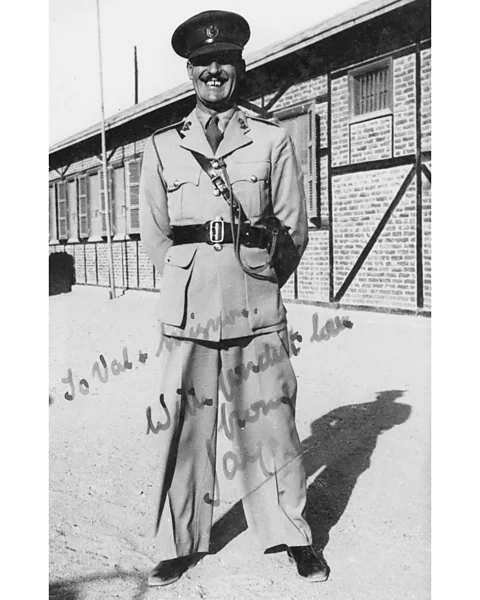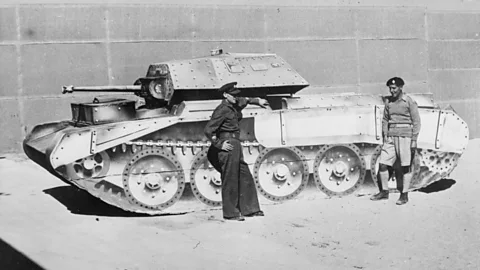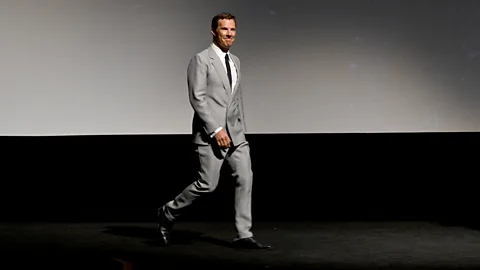Did a magician help vanquish the Nazis in World War Two?
 Alamy
AlamyJasper Maskelyne was a conjuror who allegedly helped win the war in North Africa with his trickery, though his claims have been contested. We'll never know the whole truth, writes Lucy Davies.
In the 1930s, Jasper Maskelyne was a superstar magician, performing to sell-out crowds at variety theatres all over Britain. A 1931 poster for his stint at the London Palladium billed him "England's Greatest Illusionist".
More like this:
He was a bit of a dandy, truth be told, with more than a dash of Errol Flynn about his pencil moustache and piercing eyes. Nimble, too, on the evidence of a 1937 Pathé film in which he appears to swallow a dozen razor blades. Less agile are the quips he bats to camera: "Awfully nice when they're fresh, you know."
 IWM
IWMMaskelyne's greatest hoax, however, was executed in a theatre of a very different kind – the desert near Cairo during World War Two, where he claimed to have led a team that mass-produced, as he described it in his tell-all 1949 memoir Magic: Top Secret, "tricks and swindles and devices intended to bewilder and mislead the crop-headed Axis commanders".
The smoke-and-mirrors methods that Maskelyne and co employed for "Operation Bertram" – as the deception plan for the 1942 second battle of El Alamein was called – are still studied by the military today, and a film telling Maskelyne's story starring Benedict Cumberbatch in the title role is set for production. Maskelyne also features in Spies, Lies and Deception, a new exhibition surveying the roles that fiction, misdirection and deception have played in conflicts from World War One to the present day, at the Imperial War Museum, London.
Its 150-ish objects, including gadgets, official documents, film and photography, uncloak both well and lesser-known stories, such as Noor Inayat Khan – the first female wireless operator sent into Occupied France. "We wanted to show that wars are not always fought and won on battlefields or in boardrooms," says co-curator Michelle Kirby. "So much happens in the shadows."
Since Maskelyne published his memoir, it has repeatedly been suggested that he exaggerated his individual contributions, though critics' claims – and Maskelyne's, for that matter – have been difficult to prove. "One of the fascinating but complex realities we've had to carefully navigate," says Kirby, "is that the truth of the specific involvement of people behind military deceptions is often difficult to confirm."
How his career change came about
Maskeylyne was almost 37 when war was announced. The scion of magician aristocracy – his grandfather invented the levitation trick and became famous for exposing fraudulent spiritualists – he volunteered for the Royal Engineers. The techniques of popular magic could be used for camouflage, he said, and he proved it to doubtful officers by conjuring a German warship on the Thames from a cardboard model and mirrors.
 IWM
IWMSoon afterwards, Maskelyne was approached by Brigadier Dudley Clarke. Would he consider joining MI9, as part of "A Force" – a special section of intelligence whose primary mission would be deception of the enemy?
As Clarke described it in an unpublished memoir, their aim was "to conserve rather than to destroy". Vital to their success was that, rather than just deceiving the enemy, they tricked them into assisting Allied plans.
According to Maskelyne, Clarke assigned him command of "Camouflage Experimental Section", which was nicknamed "the Magic Gang" (and by some "the Crazy Gang"). The gang allegedly included an electrician, a chemist, a stage-scenery maker, an architect, a picture restorer, a painter and a carpenter.
Together they were remarkable, not least, Maskelyne claimed, in concealing the entire city of Alexandria from German bombers. To do so, they reportedly mocked up night-lights, fake buildings, a lighthouse and anti-aircraft batteries in a bay three miles away and when the Luftwaffe flew in, even blew up some of the fake buildings so the pilots believed they had successfully hit their target.
"Deceptions like these are as old as warfare itself," Kirby tells me. "There are photos from the American Civil War of logs made to look like mounted guns, and [in the exhibition] we have a papier mâché decoy head that drew sniper fire in the trenches. But it had never been done on such a grand scale before."
His biggest moment?
According to his memoir, Maskelyne's greatest contribution to Bertram was making German Field Marshal Erwin Rommel think the Allied attack was coming from the south, when in fact Allied Field Marshal Bernard Montgomery intended to attack from the north. The magician allegedly used canvas and plywood to disguise 1,000 tanks as trucks in the north, and created 2,000 fake tanks, plus a fake railway line, fake water pipeline, fake radio conversations and fake sounds of construction in the south. The tanks even had their own pyrotechnics.
 Alamy
AlamyAccording to Maskelyne's memoir, Montgomery said to him: "The entire war will turn on what happens here… I hope you've brought your magic wand with you." "It helped the Allies obtain complete tactical surprise," says Kirby. Indeed, when troops removed their tanks' disguises and charged into battle, the Nazis were caught completely off-guard. And with the battle of El-Alamein, the Allies turned the tide of the North Africa campaign: "Before Alamein," said Winston Churchill, "we never had a victory. After it, we never had a defeat".
The Magic Gang reportedly disbanded after that, though it's believed Maskelyne's skills also lie behind the faked sabotage of the De Havilland aircraft factory at Hatfield, Hertfordshire in 1943. To fool German reconnaissance into believing that a bomb had detonated inside the factory, he allegedly built replica wooden transformers, fake bomb craters and debris. Eddie Chapman – the British double agent known as ZigZag – was used to inform the Germans of success. The Iron Cross he received in return will also be on display at the IWM.
Maskelyne received no official recognition for his war work, an omission he is said to have resented and which probably encouraged him to publish the memoir. Magic: Top Secret describes his exploits in detail – and with no little braggadocio. He even claimed to be on Hitler's personal most wanted list.
"Official accounts don’t always tally with his," says Kirby, "but the truth of what happens in the shadows of the military is hard to confirm even today. We're unlikely to ever find out how true his version of the story is.
Spies, Lies & Deception is at the Imperial War Museum, London until 14 April 2024, iwm.org.uk
If you liked this story, sign up for The Essential List newsletter – a handpicked selection of features, videos and can't-miss news delivered to your inbox every Friday.
